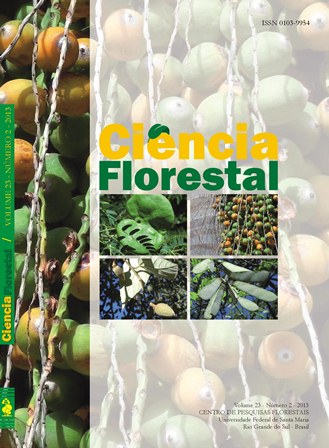COMPARISON THE METAHEURISTIC SIMULATED ANNEALING AND INTEGER LINEAR PROGRAMMING FOR SOLVING THE FOREST HARVEST SCHEDULING WITH ADJACENCY CONSTRAINTS
DOI:
https://doi.org/10.5902/198050989289Keywords:
artificial intelligence, integer linear programming, forest harvestAbstract
http://dx.doi.org/10.5902/198050989289
The impacts on the landscape after forest harvesting in reforestation are visible, but the cutting is a necessary process to ensure a sustained yield and introduce new technologies. An alternative of control is to use the adjacency constraints in the mathematical models. Thus, the aim of the study was to assess the ability of the metaheuristic SA to solve mathematical models with adjacency constraints type URM, and to check its action with the increasing of the problem complexity. The study was conducted in a forest project containing 52 stands, and created 8 scenarios, where the Johnson and Scheurmann (1977) model I was used as reference. The adjacency constraint type URM was used to control the cutting of adjacent stands. The models were solved by the ILP and metaheuristic SA, which was sued 100 times per scenario. The results showed that the scenario 8 has consumed 137.530 seconds via PLI, which represented 2.023,09 times more than the average time processing of the SA metaheuristic (67,98 seconds). The best solutions were 4.71% (scenario 1) to 11.40% (scenario 8) far from the optimal (ILP). The metaheuristic SA is capable to solve the forest problem, meeting the targets in the most cases. The increasing of complexity produced a higher deviation from the optimal. Concludes that the metaheuristic SA should not be processed a single time, because there are hazards in obtain inferior solutions, but doing it is recommended to increase the stop criterion.
Downloads
References
ALONSO, L. R. L. O problema da consideração de restrições de adjacência em um planejamento florestal. 2003. 114 f. Dissertação (Mestrado em Métodos Numéricos) - Universidade Federal do Paraná, Curitiba, 2003.
BASKENT, E. Z. Combinatorial optimization in forest ecosystem management modeling. Turkish Journal of Agriculture and Forestry, Turkey, v. 25, p. 187-194. 2001.
BELL, S.; APOSTOL, D. Designing Sustainable Forest Landscapes. Londres: Taylor & Francis, 2008. 356 p.
BORGES, J. G.; HOGANSON, H. M. Assessing the impact of management unit design and adjacency constraints on forestwide spatial conditions and timber revenues. Canadian Journal of Forest Research, Canada, v. 29, n. 11, p. 1764-1774, 1999.
BOSTON, K.; BETTINGER, P. The economic impact of green-up constraints in the southeastern United States. Forest Ecology and Management, Netherlands, v. 145, n. 3, p. 191-202, 2001.
BRUMELLE, S. et al. A tabu search algorithm for finding good forest harvest schedules satisfying green-up constraints. European Journal of Operational Research, Netherlands, v. 106, n. 2, p. 408-424, 1998.
CASTRO, R. R. Regulação de florestas equiâneas incluindo restrições de adjacência. 2007. 64 p. Dissertação (Mestrado em Engenharia Florestal) - Universidade Federal de Viçosa, Viçosa, 2007.
CROWE, K. A.; NELSON, J. D. An evaluation of the simulated annealing algorithm for solving the area-restricted harvestscheduling model against optimal benchmarks. Canadian Journal of Forest Research, n. 35, p. 2500-2509, 2005.
FALCÃO, A. O.; BORGES, J. G. Heurísticas para a integração de níveis estratégico e operacional da gestão florestal em problemas de grande dimensão. Scientia Forestalis, n. 63, p. 94-102, 2003.
GLOVER, F.; KOCHENBERGER, G. A. Handbook of metaheuristics. Nova Iorque: Kluwer, 2003. 557 p.
GOMIDE, L. R.; ARCE, J. E.; SILVA, A. L. Efeito das restrições espaciais de adjacência no planejamento florestal otimizado. FLORESTA, Curitiba, v. 40, n. 3, p. 573-584, 2010.
GOYCOOLEA, M. et al. Harvest scheduling subject to maximum area restrictions: Exploring the exact approaches. Operational Research, v. 53, n. 3, p. 490-500, 2005.
HERRMAN, J.W. A history of production scheduling. p.1-22. In: HERRMAN, J.W. (Ed.) Handbook of production scheduling. Nova Iorque: Springer. 2006. 318 p.
HOOKER, J. N. A principled approach to mixed integer/linear problem formulation. p. 21. 2008. Disponível em: <(http://ba.gsia.cmu.edu/jnh/milpmodeling.pdf)>. Acesso em: 06 agosto de 2008.
HOTVEDT, J. E. Application of linear goal programming to forest harvest scheduling. Southern Journal of Agricultural Economics, v. 15, p. 103-108, 1983.
JOHNSON, K. N.; SCHEURMANN, H. L. Techiniques for prescribing optimal timber harvest and investment under different objectives - discussion and synthesis. Forest Science, v. 18, n. 1, p. 1-31, 1977.
KIRKPATRICK, S.; GELATT, C. D.; VECCHI, M. P. Optimization by Simulated Annealing. Science, v. 220, n. 4598, p. 671-680, 1983.
LAARHOVEN, P. J. V.; AARTS, E. H. Simulated Annealing: Theory and Applications. Amsterdam: Springer. 1987. 204 p.
MURRAY, A. T.; GOYCOOLEA, M.; WEINTRAUB, A. Incorporating average and maximum area restrictions in harvest scheduling models. Canadian Journal of Forest Research, Canada, v. 34, p. 456-464, 2004.
MURRAY, T.; SNYDER, S. Introduction to spatial modeling in Forest managemant and natural resource planning, Forest Science, v. 46, n. 2, p. 153-154, 2000.
PEZESHK, S.; CAMP, C. V. State of the on the use of genetic algorithm in design of steel structures. p.200-250. In: BURNS, S. A. (Ed.) Recent advances in optimal structural design. Reston: ASCE. 2002. 312 p.
RODRIGUES, F. L. et al. Metaheurística simulated annealing para solução de problemas de planejamento florestal com restrições de integridade. Revista Árvore, Viçosa, v. 28, n. 2, p. 247-256, 2004.
SILVA, G. F. et al. Problemas com o uso de programação linear com posterior arredondamento da solução ótima, em regulação florestal. Revista Árvore, Viçosa, v. 27, n. 5, p. 677-688, 2003.
SUMAN, B; KUMAR, P. A survey of simulated annealing as a tool for single and multiobjective optimization. Journal of the Operational Research Society, United Kingdom, v. 57, n. 10, p. 1143-1160, 2006.
WEINTRAUB, A. et al. Forest management models and combinatorial algorithms: analysis of state of the art. In: ANNALS OF OPERATIONS RESEARCH, 2000, San Antonio. Proceedings…San Antonio, 2000. p.271-285.
WEINTRAUB, A.; BARAHONA, F.; EPSTEIN, R. A column genetation algorithm for solving general forest planning problem with adjacency constraints. Forest Science, v. 40, n. 1, p. 142-161, 1994.
ZHU, J.; BETTINGER, P.; LI, R. Additional insight into the performance of a new heuristic for solving spatially constrained forest planning problems. Silva Fennica, Finland, v. 41, n. 4, p. 687-698, 2007.







